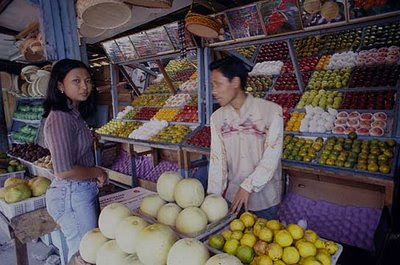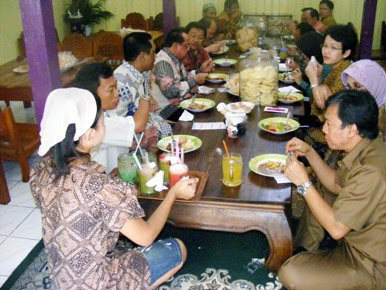Street Food Stall
(Warung)
Everywhere you look you see them: clustering at the perimeters of the pasar malam (night market), sprouting like mushrooms on sidewalks next to busy intersections, of lining the narrow footpaths between buildings. Indonesian street food is the ultimate fast food and it's ubiquitous. When you travel in Indonesia, you needn't miss out on good home cooking either. Loads of street food is prepared ahead of time in the cook's home and according to traditional family recipes.
Every morning they set to work, orchestrating flavors and textures as varied as the islands they hail from. Using all kinds of aromatic roots, leaves, and spices, delicious flavors are coaxed out of ordinary meats, vegetables, and rice. Bitter papaya leaves are sautéed with sweet shallots. Palm sugar is livened up with a dose of sour tamarind and the fire of tiny chili peppers blast holes through the pristine tranquility of coconut milk. Soon all of it will be packed up and sold door to door, or hawked on trains and busses, or of course sold at your friendly neighborhood street food stall. They really excellent cooks are gossiped about and can gain quite a reputation. Before long you might see a few fat BMWs parked in front of their stalls with the well-heeled owner queuing inside.
Food vendor's peddle their trade in venues that span the gamut of shape and size. Pikulan are compact walking restaurants which the cooking equipment is suspended between the ends of a bamboo pole. The pole is then hoisted onto the shoulders of the humble chef who walks along his route rhythmically beating a wooden drum or gong to announce his presence. Kaki Lima (five legs) are three-wheeled push carts with the addition of two human legs to push them anywhere appetites are to be found.
Lesehan are sidewalk cafes that are set up entirely on the sidewalk. Starting late in the afternoon, bamboo mats are laid out, sometimes accompanied by short little tables. Romancing buckers will often serenade you as you sit on the mat and eat.
Warungs are only slightly more permanent establishments, constructed of wood and bamboo. A simple counter is enclosed by a cloth or plastic canopy that doubles as a banner to advertise the warung's specialty. Gas lamps hiss from the rafters above illuminate a galaxy of hastily packaged consumables, bottled fizzy drinks, and the usual as assortment of specialty items wrapped in banana leaves. Like lesehans, warungs often stay open until wee hours of morning.
The next step up from the warung, is the rumah makan, literally house of eating. When you sit down in one of these places a young boy or girl will often drop off a menu and a pad of paper and pencil. You're expected to jot down your order, but this can use up a lot of lead as they're often sold out of most what's on the menu. One way around this is to point to what others are having, if it looks good that is. Or you can head boldly into the kitchen-they won't mind-and start interrogating people. The staff will most likely have a good laugh over it.
Another interesting type of rumah makan is named after Padah, a city in Southern Sumatra where the restaurants put everything on theur menus into big bowls which they then stack like a house of cards in the window. This makes it easy to spot a padang restaurant from the outside, and inspect the food before going in. When you take a seat inside the waiter will cover your table with little bowls that replicate the variety in the window. Somehow they keep tract of what you eat and present you with the bill upon finishing. Padang restaurants have sprung up all over Indonesia.

Bookmark/share this article with others:Every morning they set to work, orchestrating flavors and textures as varied as the islands they hail from. Using all kinds of aromatic roots, leaves, and spices, delicious flavors are coaxed out of ordinary meats, vegetables, and rice. Bitter papaya leaves are sautéed with sweet shallots. Palm sugar is livened up with a dose of sour tamarind and the fire of tiny chili peppers blast holes through the pristine tranquility of coconut milk. Soon all of it will be packed up and sold door to door, or hawked on trains and busses, or of course sold at your friendly neighborhood street food stall. They really excellent cooks are gossiped about and can gain quite a reputation. Before long you might see a few fat BMWs parked in front of their stalls with the well-heeled owner queuing inside.
Food vendor's peddle their trade in venues that span the gamut of shape and size. Pikulan are compact walking restaurants which the cooking equipment is suspended between the ends of a bamboo pole. The pole is then hoisted onto the shoulders of the humble chef who walks along his route rhythmically beating a wooden drum or gong to announce his presence. Kaki Lima (five legs) are three-wheeled push carts with the addition of two human legs to push them anywhere appetites are to be found.
Lesehan are sidewalk cafes that are set up entirely on the sidewalk. Starting late in the afternoon, bamboo mats are laid out, sometimes accompanied by short little tables. Romancing buckers will often serenade you as you sit on the mat and eat.
Warungs are only slightly more permanent establishments, constructed of wood and bamboo. A simple counter is enclosed by a cloth or plastic canopy that doubles as a banner to advertise the warung's specialty. Gas lamps hiss from the rafters above illuminate a galaxy of hastily packaged consumables, bottled fizzy drinks, and the usual as assortment of specialty items wrapped in banana leaves. Like lesehans, warungs often stay open until wee hours of morning.
The next step up from the warung, is the rumah makan, literally house of eating. When you sit down in one of these places a young boy or girl will often drop off a menu and a pad of paper and pencil. You're expected to jot down your order, but this can use up a lot of lead as they're often sold out of most what's on the menu. One way around this is to point to what others are having, if it looks good that is. Or you can head boldly into the kitchen-they won't mind-and start interrogating people. The staff will most likely have a good laugh over it.
Another interesting type of rumah makan is named after Padah, a city in Southern Sumatra where the restaurants put everything on theur menus into big bowls which they then stack like a house of cards in the window. This makes it easy to spot a padang restaurant from the outside, and inspect the food before going in. When you take a seat inside the waiter will cover your table with little bowls that replicate the variety in the window. Somehow they keep tract of what you eat and present you with the bill upon finishing. Padang restaurants have sprung up all over Indonesia.




















0 comments:
Post a Comment